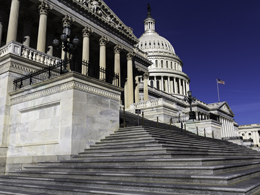 Once again, we’ve hit the federal government’s borrowing limit. Having maxed out its credit card with the bond markets, the U.S. government is now pursuing the “usual emergency measures” while waiting for Congress to approve an increase in the debt limit.
Once again, we’ve hit the federal government’s borrowing limit. Having maxed out its credit card with the bond markets, the U.S. government is now pursuing the “usual emergency measures” while waiting for Congress to approve an increase in the debt limit.
We’ll probably be hearing about this, at high volume, for quite a while—and, based on past experience, right up until the last minute—so it’s worth understanding what is likely to happen.
Not exactly a crisis
Just as with the last two go-rounds, there’s no economic reason that hitting the debt limit should be a crisis. The problems are political and center around getting an agreement that enough members of Congress support. Unlike last time, though, the battle will not be between the Republicans and Democrats, at least initially, but between different Republican factions.
With Republicans controlling both houses of Congress, there is, in theory, no place for the Democrats to insert themselves in the political machinery until a bill is sent to the White House for signature or veto. I suspect they are quietly grateful for this and very willing to let the Republicans battle it out on their own.
The two major groups in play appear to be Republican defense hawks and fiscal hawks. Defense hawks are insisting on spending more on the military than the law allows, and the fiscal hawks are insisting that total spending remain within the constraints of the law.
What is this law?
Remember the fiscal cliff? Well, it was resolved by the Budget Control Act of 2011, which placed caps on government spending for the next 10 years. Those constraints, better known as “the sequester,” are still in place, limiting proposed spending. In order to spend more than the law allows, the act would have to be modified or repealed.
From a commentator’s perspective, all I can say is “thank you” to the U.S. government. This will give me lots to write about. From a citizen’s perspective, all I can say is “here we go again.” We can now look forward to a couple of months of increasingly contentious public debate, along with rising panic about the implications of an eventual default on U.S. debt.
Why I’m not really worried
I’d be more concerned had we not been through this before—several times. I would be more concerned if I wasn’t confident that Congress will, after exhausting all other alternatives, do the right thing. I would be more concerned if the politics lined up differently.
But this time around:
- Both the Democrats and a substantial part of the Republican Party want to spend more. There is a centrist coalition capable of acting.
- The economy is much stronger than in the previous confrontations.
- The most hard-line of the fiscal hawks on the Republican side have consistently lost at the end of the day.
I’ve written about this before, many times. If you want to look ahead to where we might be going, check out this piece I wrote in late 2013, which attempted to tie everything together. In retrospect, it did a pretty good job of describing the problem and how it was likely to be solved.
We will be returning to this topic—again and again, I suspect—but for the moment, just remember one thing: although the debt limit will be a major headline generator, it will very probably come to nothing.


 Print
Print


